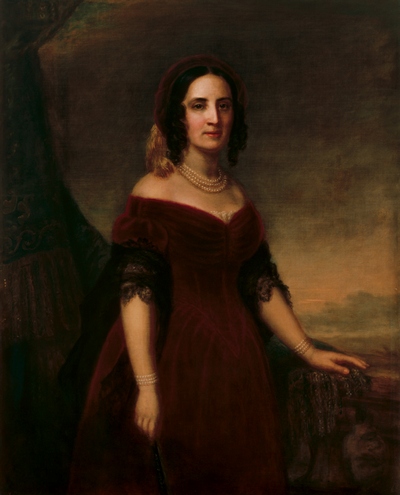Sarah Childress Polk (Sarah Childress Polk)

Sarah Childress was born in 1803 to Joel Childress, a prominent planter, merchant, and land speculator, and Elizabeth Whitsitt Childress—the third of their six children. Sarah was well educated for a woman of her time and place, attending the exclusive Moravians’ Salem Academy in Winston-Salem, North Carolina in 1817, one of the few institutions of higher learning available to women in the early 19th century.
Sarah met James Polk while both were receiving instruction from Samuel P. Black in Murfreesboro, Tennessee; he was 19, she was 12. Several years later James began courting her. Legend says Andrew Jackson called her “wealthy, pretty, ambitious, and intelligent,” and urged James K. Polk to marry her. In 1823 the two became engaged, and on January 1, 1824, Sarah Childress, aged 20, married James Polk, aged 28, at the plantation home of the bride’s parents near Murfreesboro. The Polks had no children of their own, but raised a niece, Marshall Tate Polk (1831–1884) as their personal ward. After her husband’s death, Mrs. Polk assumed guardianship of an orphaned niece, Sarah Polk Jetton (1847–1924), and raised the girl as her own.
In physical appearance, Sarah was fairly tall, with black hair that was parted in the middle and worn in ringlets, dark brown eyes and olive complexion. She had prominent teeth that caused her to tighten her lips, giving her a disapproving look, though she was admired as a “noble” beauty. She usually dressed in vibrant blues, reds and maroons, that suited her dark coloring.
During Polk’s political career, Sarah assisted her husband with his speeches, gave him advice on policy matters and played an active role in his campaigns. In Washington as congressman’s wife during the administrations of John Quincy Adams, Andrew Jackson, and Martin Van Buren, Mrs. Polk very much enjoyed her social duties. In 1830 she risked a breach with Jackson, her husband’s mentor, by taking part in the social ostracism of Peggy Eaton, during the Petticoat Affair, although she continued to greet Eaton, unlike Vice President John C. Calhoun’s wife, Floride Calhoun, and most of the cabinet members’ wives.
In 1845, Sarah Polk became the 11th First Lady of the United States She was lively, charming, intelligent, and a good conversationalist. President Polk at times discussed policy matters with her. While she enjoyed politics, she also cautioned Polk, whose health was never robust, against overwork. A devout Presbyterian, as First Lady she banned dancing, card games, and hard liquor at official receptions and refused to attend horse races or the theatre. When she attended the Inaugural Ball, she did not dance. She hosted the first annual Thanksgiving dinner at the White House.
Unlike Julia Tyler’s waltzes, the Polk entertainments were sedate and sober affairs which earned the First Lady the nickname “Sahara Sarah”. Although some accounts stated that the Polks never served wine, a Congressman’s wife “recorded in her diary details of a four-hour dinner for forty at the White House—glasses for six different wines, from pink champagne to ruby port and sauterne, ‘formed a rainbow around each plate.'”
After attending the inauguration of James Polk’s successor, Zachary Taylor, on March 6, 1849, he and Sarah left by horse and carriage to their new home “Polk Place” in Nashville, Tennessee. Three months later, James Polk died, having had the shortest retirement of any former U.S. President. The United States government granted her a yearly pension of $5,000. During the American Civil War, she was officially neutral, but indicated sentiments in favor of preserving the Union during periodic visits to her home by several Union Army commanders, including Don Carlos Buell, George Henry Thomas, Ulysses S. Grant, and William T. Sherman. Sarah Polk lived at Polk Place for 42 years, the longest retirement and widowhood of any former US First Lady, and always wore black. She died on August 14, 1891, at age 87, and was buried next to the president at their home in Nashville and was later reinterred with him at the Tennessee State Capitol.
Only 41 when her husband became president, she outlived several of her successors including Margaret Taylor, Abigail Fillmore, Jane Pierce, Mary Todd Lincoln, Eliza Johnson and Lucy Webb Hayes. Only a handful of first ladies have lived longer — Anna Harrison, Barbara Bush, Edith Bolling Wilson, Betty Ford, Lady Bird Johnson, Nancy Reagan, and Bess Truman.
Born
- September, 04, 1803
- USA
- Murfreesboro, Tennessee
Died
- August, 14, 1891
- USA
- Nashville, Tennessee
Cemetery
- Tennessee State Capitol Building and Grounds
- Nashville, Tennessee
- USA





